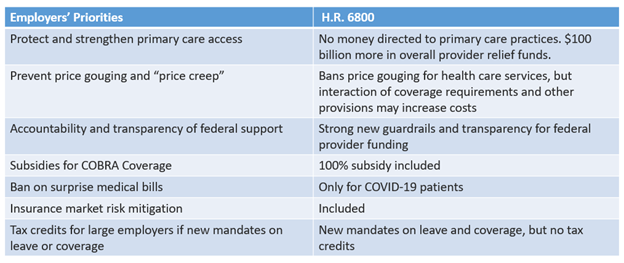The New Political Landscape: 3 Opportunities for Employers to Shape Health Policy
The outcome of the presidential race has ended with Joe Biden the new President-elect, and the potential of a split Congress. The new political landscape has significant implications for large employers and health care purchasers, PBGH policy experts explained in a members-only webinar the morning after the election, Nov. 4.
If Democrats and Republicans maintain control of the House and Senate, respectively, a continued partisan stalemate is likely. That means that major health policy changes are unlikely, according to Bill Kramer, PBGH’s executive director of Health Policy, and Shawn Gremminger, director of Health Policy.
Top Priorities for Large Employers
Opportunities nonetheless may emerge for legislative action. With a Biden win and Republican Senate – the most likely outcome given where the race currently stands – we see three areas of potential policy activity that could impact large corporations and the health benefits they extend to their employees:
1) Prescription drug costs: Employers are deeply concerned about high-priced drugs, and view this as a top issue. In fact, a poll taken during the post-election webinar found that 71% of employers feel that prescription drug pricing reform should be a top federal priority for 2021.
With a Biden administration and Republican-led Senate, it’s still possible that we’ll see movement on legislation improving transparency and even capping price increases. In addition, we could see limits on anti-competitive practices, such as pay-for-delay and other patent-related tactics, although they would face strong opposition from the pharmaceutical industry. These actions could lead to significant savings for large health care purchasers, and by extension, employees who receive health benefits on the job.
2) Surprise billing: This continues to be a serious problem, and there is bipartisan support to pass legislation to eliminate surprise billing. Congress has been deadlocked, however, on the best way to limit the prices charged by providers who have not signed a contract to be “in-network” with a health plan If we can find a way to break the stalemate and set limits using existing local, market-based contract rates, there would be real savings for employers and protections for patients.
3) High health care costs: High health benefit costs come at the expense of core business investments and hold down wages, dampen business growth and squeeze family budgets. The COVID pandemic and the related economic recession are making this growing crisis completely untenable as unemployment soars and many employers face existential threats.
Nearly 60% of employers who attended the PBGH post-election webinar said that policies to reduce health care costs beyond prescription drugs were a top priority heading into 2021.
Large employers would welcome action to accelerate the transition from fee-for-service to value-based payment models, which would help shift provider incentives from volume to quality and value. This could be accomplished by administrative action to introduce, test and spread value-based clinician payment and care models, especially for primary care.
In addition, health system consolidation has been a major driver of rising costs, and employers see a long-term benefit to stronger anti-trust enforcement and new prohibitions on anti-competitive practices, both of which are possible in the coming year.
Taking the Fight Against Rising Costs, Inequity Into Their Own Hands
Regardless of the ultimate makeup of the Senate, employers attending the PBGH post-election webinar identified several priorities they were likely to pursue on their own to stem rising health care costs, particularly in the wake of COVID.
Half (50%) said they planned to alter their company’s drug formularies to eliminate wasteful spending, and 44% said they intended to engage in value-based contracts to strengthen primary care. Another 50% indicated they would invest in methods to address inequities in care delivery and outcomes.
The days and weeks ahead will make clearer the configuration of our federal government post-election. We will have the opportunity to address the problems of high costs, inconsistent quality and racial disparities through administrative action as well as legislation, and the voice of employers will be an important influence in the upcoming health policy debates.
